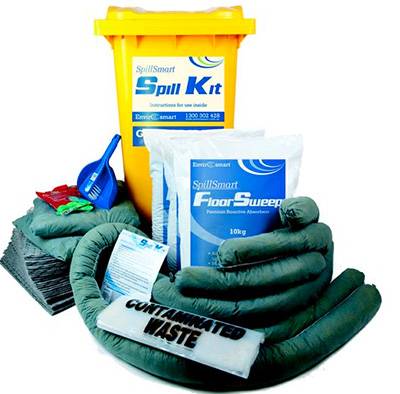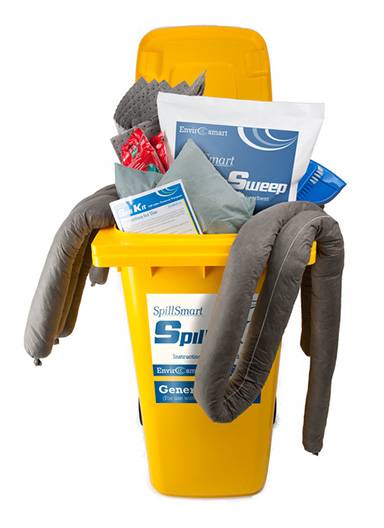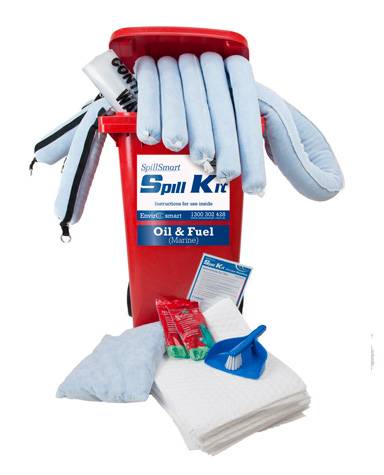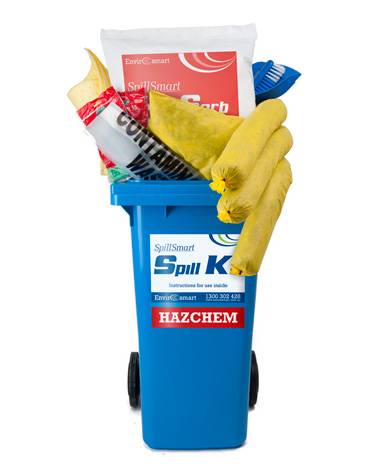Regardless of your workplace, even if you have never considered a spill kit, you are likely to have to deal with spills at some time. There are potential problems associated with spills of any nature. For some workplaces, this might not be a serious problem e.g. when spills don’t represent an environmental hazard such as stormwater contamination and or land contamination. However, any spill can be a trip hazard and poses risk to health and safety, and requires immediate attention. Knowing what type of spill kit is best suited for your requirements along with developing a spill response plan, therefore, should be of importance to the business owner.
For those dealing with Hydrocarbon or chemical spills it’s crucial that spills are dealt with quickly and an effective spill response plan is in place, not only to ensure the health and safety of your staff but to also ensure your workplace is environmentally compliant. A spill response plan’s basic requirement is to identify and mitigate the risk. In some cases that’s as easy as placing a spill kit in the right location and making sure staff are made aware and trained to use it. Spill kits form a crucial part of any spill response plan in the workplace but there are different options available and many of our customers have expressed confusion over which spill kit or kits will best suit their requirements.
We have put together the following guide to walk you through the process of choosing the right spill kit for your workplace. Please note this guide is also available as a PDF download at the bottom of the page.
So…..if you have ever wondered:
- What exactly are spill kits and what are they used for?
- What types of spill kits are available?
- Does my workplace even require a spill kit?
- Which kit is right for your business?
- How to use a spill kit and develop a spill response plan.
Then this article should be of value to you.
Spill Kit Contents
As the name implies spill kits are essentially kits that combine a number of spill response products that assist with spills in the workplace. While spill kits do vary based on their intended application most spill kits contain one or more of the following spill response products:
- Mini Booms For blocking spills from entering the stormwater network. These are positioned directly in front of the spill to avoid it spreading and entering unwanted areas such as stormwater pits and drainage systems
- Absorbent pads For effective absorption, PADS are placed directly in contact with the spill
- Safety gloves are required for handling spill response products that become contaminated. Spill kits should have the required PPE for the type of spill they are designed for
- Sorbent or floor sweep For absorbing and encapsulating spills such as hydrocarbons from hard surfaces that can also leave residue
- Disposal bags For safe disposal of contaminants
- Spill response instructions are Generally printed on a spill kit to ensure best practices are followed; some suppliers do not add instruction.

The right spill kit or kits for your workplace will depend on your requirements and are typically broken up into the following three categories:
- General-purpose or universal spill kits
- Fuel and Oil or Hydro-carbon Spill Kits
- Hazchem Spill Kits (Chemical spill kits)
Does My Workplace Need a Spill Kit?
The short answer is all businesses with spill risk should have a spill response plan in place and as noted above spill kits are central to any spill response plan. For one, it’s everyone’s responsibility to protect the environment, and almost any type of spill that isn’t contained and enters our waterways has the capacity to be an environmental hazard. Secondly, any business that is considered responsible for pollutants entering the stormwater network can be reported and fined heavily by the Authority (EPA, DERM, etc) In some cases this process can be as simple as a member of the public noticing a contaminant entering a waterway and reporting it which will then investigate the possible cause. The EPA has a pollution hotline that any member of the public can call and report an environmental hazard. It’s also worth noting that most Authorities are also active in investigating workplaces for unsafe practices.
Types of Spill Kits.
Which Spill Kit is Right For Your Business?
As previously mentioned at-risk workplaces should have a spill response plan in place but having the wrong spill kit (or kits) can potentially lead to an even bigger problem than the actual spill. Before selecting a spill kit for your workplace you should first identify your potential spill risks. Spill risks might include:
- Fuel and Oil Products for vehicles or other machinery
- Hydraulically operated equipment
- Industrial cleaning agents such as degreasers and detergents
- Chemical Compounds that are added to your products e.g. Sulfates and Emulsifiers
- Solvents and Acids
- Paints and thinners
- Farming pesticides, fertilizers, and irrigation products
Once you have identified your potential spill risks you should then consult your MSDS (Material Safety Data Sheets) for correct spill response practices. In some cases, you may need to contact the supplier for more detailed information relating to your use of the product and how it is stored. Business owners that don’t take shortcuts here will avoid the potential pitfalls of a spill response going badly and avoid heavy fines and in some cases bad publicity. It’s not only imperative you have the right spill kit available for the right application you should also have the correct PPE (personal protection equipment) for handling a spill response.
General Purpose Spill Kits
This type of spill kit is designed for non-hazardous applications. Generally speaking, workplaces that identify potential spill targets that are nonhazardous should have general-purpose spill kits in place. These types of spill kits are typically available in the following:
Generally speaking, this type of spill kit is ideally suited for workplaces such as:
- Food processing plants
- Schools
- Wineries
- Milk factories
- Shopping complexes
- Farms
- Food and beverage processing plants
- Some farming applications

In most cases we are talking about workplaces that need to contain spills mostly due to the spill being a physical hazard e.g. may cause a person to slip over or is unsightly.
A general-purpose or universal spill kit can also be used for some oil and fuel applications where the spill is not in contact with water. For a general example, a mechanical shop floor could use a universal or oil and fuel pad and get the same result however generally as a rule one will cost less than the other, so if you’re a big user of these consumables it pays to understand your risk and the applicable products to mitigate them.
Fuel And Oil Spill Kits
This type of spill kit is suited to workplaces that deal with Hydrocarbon spills, such as fuels and machinery oil, and are usually very well suited for spills on water and land. This might include any workplace where mechanical work is carried out such as workshops and warehouses or for larger industrial and hydraulic applications such as mariners and ports, cargo facilities airports, construction yards, SMEs.
Fuel Oil Spill Kits are effective when oil is spilled on the water as the hydrophobic characteristics of these kits mean they won’t absorb water meaning they will only remove the hazardous liquids that have been spilled. A universal absorbent Pad cannot work on a fuel spill on the water as it will saturate with water as well fuel providing no value for money Fuel and oil kits are typically available in standard sizes:
- Vehicle spill kits (generally 2 X options with or without absorbents)
- 140 L or 240 L (Wheelie Bin)
- 660L wharf and Port kits
- Custom designed to target risk

Hazchem Spill Kits
Hazchem spill kits are essential for any workplace where the capacity for chemical spills can occur. Chemical spills can endanger the health and safety of those in the workplace as well as present an urgent environmental hazard if not contained quickly and dealt with effectively. It’s critical that the right type of Hazchem spill kit is used based on the type of chemical spill that occurs. For instance, If the wrong absorbent product is used it can actually make a chemical spill more of concern e.g. the wrong absorbent can be a potential fire risk or cause harmful gasses to be created which can endanger human life depending on the chemical.
Generally speaking when there is a requirement for a chemical spill kit you are well-advised to talk to your supplier about the type of chemicals you require spill protection for along with consulting your MSDS. In Most cases, Hazchem spill kits can cater to a fairly wide range of chemical spills with pH ranges between 4-10 but you are well-advised to speak to your supplier first before having an unsafe spill response plan in place and you should never base the plan on a chemical’s pH, this is a guide and usually, the MSDS will state the correct method of spill response and products to be used.

How to use a Spill Kit
Now that you have a better idea of what’s contained within a Spill Kit and the type of Kit that will best suit your business it’s a good time to develop a spill response plan and ensure staff members responsible for spills have basic training and understand what’s required in the event of a spill. Your spill kit should also display clear instructions in the event non-trained personnel are attending.
The steps below outline a typical spill response plan.
- Identify the type of spill and the source of the spill and the risk to humans.
- Evacuate or evaluate PPE requirements. (eye protection, masks, gloves clothing, and footwear for a start)
- Contain the Spill and plug the source using products from the spill kit such as mini booms, pads, and absorbent; (containing the spill ensures it does not end up down a drain where a spill can get away from the site). This process may require two people.
- Absorb and clean up the Spill using the Spill kit products
- Clean up equipment using wipes and rags and ensure the site is safe and not a slip, trip, or general safety hazard to people. Use the disposal bags provided in the kit.
- Identify the source and cause of the spill and report it to someone in charge of Spill response so they can evaluate the Spill response plan and ensure it does not happen again. That Person will know if the spill requires reporting to the Authority. In some cases, a significant spill should be reported to the local authority along with the clean-up method and disposal method.
- Dispose of all cleaning equipment in a sealed bag and then dispose of it.
Following the steps listed above will ensure you deal with spills effectively and make correct use of your spill kit.

